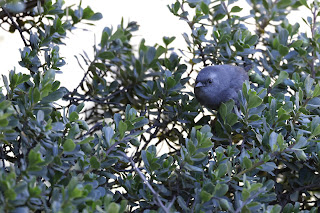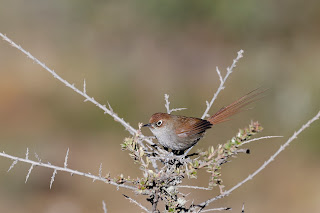This was our final day in the high Altiplano for some time, as today we would endure the long Satipo road down the east slope into the lowlands of the Andean foothills. Fortunately, we had already seen many of the species we had hoped to find on the way, which meant a day with substantial driving but few target birds, at least until we reached the lowlands in the afternoon.
The road did pass through some stunning scenery, especially
early morning when a thick frost had set across the mountains. About an hour
into the drive we passed the partly frozen Laguna Pomacocha, stunning in the morning light. We found a few commoner species here,
including Ochre-naped Ground-Tyrant and Chilean Flamingo, but perhaps the
highlight was an Andean Negrito, running around on one of the smaller
frozen lakes.
After two and a half hours driving we finally arrived in the
area were we might find our only outstanding target, the rare and local Eye-ringed
Thistletail. But as soon as we pulled up, we had two of these Thistletails
in the bushes directly below us, showing well. Having managed to clean up in
five minutes we spent the next 15 minutes birding along the road. I
concentrated on finding another Jalca Tapaculo, and quickly found a bird
calling, although not showing. Not to worry however, as just down the road there
was another individual who did decide to show well, incredibly well at one
point, perched out over the cliff. It was a fantastic Tapaculo encounter, with
brilliant views and photos managed.
The rest of the drive, all two and a half hours of it,
passed without much incident. We did manage to tick off Andean Ibis feeding in
high-altitude pastureland. Towards the end of the road it began to descend into
more forested habitat. We managed to add a couple more Jalca Tapaculos,
including one that showed deep inside the bamboo. However, in the edge habitat
between the woodland and the altiplano, we found very little.
After finding a ‘hostal’ in the town of Calabeza, we set off out into the nearby forest. The term hostal was generous, as it was actually just four beds in what would barely pass as a garden shed. Still it was our only option and we are not fussy, so for its location alone, would suffice. The forest was extremely productive for the hour and a half we were able to bird there. There was just a single new bird for me with Dusky-green Oropendula, but the flocks of tanagers were absolutely fantastic with Flame-faced, Saffron Cowled and Blue-capped all being common. There was also Capped Conebill, Black-eared Hemispingus and Citrine Warbler. An Andean Guan was also a nice bonus roosting at the end of the afternoon, and a pair of Chestnut-breasted Coronet. It was our first experience of Andean forest birding on this trip, and it did not disappoint.
Laguna Pomacocha: Andean Goose, Crested Duck, Yellow-billed Teal, Andean Duck, Chilean Flamingo, Silvery Grebe, Andean Lapwing, Andean Gull, Mountain Caracara, Common Miner, Andean Negrito, Ochre-naped Ground Tyrant,
Upper Satipo Road: Andean Goose, Torrent Duck, Andean Lapwing, Puna Ibis, Andean Ibis, Mountain Caracara, Jalca Tapaculo, Eye-ringed Thistletail, Brown-backed Chat-Tyrant, Black-throated Flowerpiercer, Rufous-collared Sparrow, Peruvian Sierra Finch,
Calabaza: Andean Guan, Speckled Hummingbird, Long-tailed Sylph, Collared Inca, Chestnut-breasted Coronet, Roadside Hawk, Plum-crowned Parrot, Montane Woodcreeper, Barred Becard, Cinnamon Flycatcher, Tufted Tit-Tyrant, Sierran Elaenia, Black Phoebe, Rufous-tailed Tyrant, Streak-throated Bush Tyrant, Blue-and-white Swallow, House Wren, Great Thrush, Rufous-collared Sparrow, Tricolored Brushfinch, Dusky-green Oropendola, Citrine Warbler, Spectacled Whitestart, Black-eared Hemispingus, Superciliaried Hemispingus, Blue-capped Tanager, Buff-breasted Mountain Tanager, Blue-grey Tanager, Blue-and-black Tanager, Saffron-crowned Tanager, Flame-faced Tanager, Capped Conebill, Masked Flowerpiercer,





















No comments:
Post a Comment